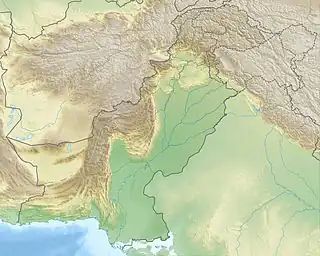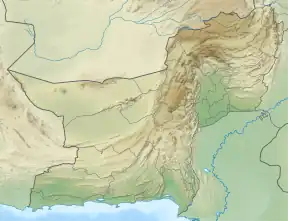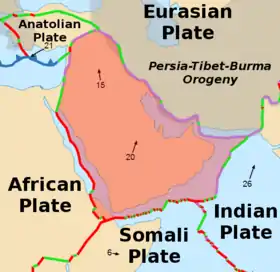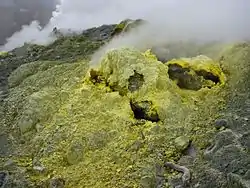Koh-i-Sultan
Koh-i-Sultan is a volcano in Balochistan, Pakistan. It is part of the tectonic belt formed by the collision of the Eurasian Plate and Indian Plate: specifically, a segment influenced by the subduction of the Arabian plate beneath the Asian plate and forming a volcanic arc which includes the Bazman and Taftan volcanoes in Iran. The volcano consists of three main cones, with heavily eroded craters running west-northwest and surrounded by a number of subsidiary volcanic centres. Its summit is 2,334 metres (7,657 ft) high, and the crater associated with the Miri cone has a smaller crater inside.
| Koh-i-Sultan | |
|---|---|
| Koh-e-Sultan, Kuh-i-Sultan, Kuh-e-Sultan | |
 Koh-i-Sultan  Koh-i-Sultan Koh-i-Sultan (Balochistan, Pakistan) | |
| Highest point | |
| Elevation | 2,334 m (7,657 ft) |
| Coordinates | 29°7′20″N 62°49′1″E |
| Naming | |
| English translation | Mountain of the King |
| Geography | |
| Location | Balochistan, Pakistan |
| Geology | |
| Age of rock | Miocene-Late Pleistocene |
| Mountain type | Stratovolcano |
| Volcanic arc | Sultan/Makran/Baluchistan volcanic arc |
| Last eruption | 90,000 ± 10,000 years ago |

The volcano is formed by andesite and dacite rocks, with fragmentary rocks prevailing over lava flows. The rocks have typical arc-volcano chemistry and composition, with a progression from andesite to dacite in the eruption products with younger age. Potassium-argon dating has indicated an age range from 5,900,000 to 90,000 years. Subsequent erosion has generated a large debris apron around the base of the volcano and carved rock formations which impressed early explorers; one well-known rock formation is Neza e Sultan.
Geothermal activity and the emission of volcanic gases are ongoing, and the volcano has been prospected for the possibility of obtaining geothermal energy. The geothermal activity has resulted in widespread rock alteration and the formation of sulfur deposits, which were mentioned in a 1909 report and later mined. Koh-i-Sultan also has deposits of other minerals.
Geography and geology
Political geography and human history
Koh-i-Sultan is in the Chagai District of the Quetta Division,[1] Baluchistan, Pakistan.[2] A nearby settlement is the Nokkundi railway station, 37 kilometres (23 mi) south.[3][4] Henry Walter Bellew was the first to report the volcano's existence in 1862,[5] and the Geological Survey of British India conducted mining and reconnaissance operations from 1941 to 1944.[6] In 1961, a truck-accessible mining road was built from Nokkundi to the volcano's summit.[7] Its name, translated as "Mountain of the King", is a reference to a saint in the local Baluchi religion.[5]
Regional

Pakistan is part of the active tectonic belt which is responsible for the formation of the Himalayas following the collision of the Eurasian and Indian plates. As a result of this activity, hydrothermal alteration and hydrothermal activity are expected to be widespread in Pakistan.[8] Koh-i-Sultan is the youngest volcano in Pakistan.[9]
It is tectonically influenced by the Arabian Plate subducting beneath the Eurasian Plate, forming the Chagai volcanic zone. Tectonic activity related to this subduction is ongoing.[2] Before the onset of volcanic activity at Koh-i-Sultan in the early Quaternary, tectonic uplift occurred in the region.[10] Koh-i-Sultan and the Iranian volcanoes Bazman and Taftan form the Sultan volcanic arc.[11] Also known as the Makran[12] or Baluchistan volcanic arc, it is c. 500 kilometres (310 mi) long and stretches in an east-northeast direction.[13] Magma generated by the relatively shallow subduction of the Indian Plate rises to the surface and forms the andesitic rocks, among others, of Taftan and Koh-i-Sultan.[14][15] The related Makran subduction zone is one of the few Cretaceous zones still active, and has formed a large accretionary prism.[16]
Local

Koh-i-Sultan is a volcanic complex[5] with at least three cones,[17] named Kansuri, Abu and Miri after their respective summits.[18] Each has a central crater[17]—the largest of which is over 5 kilometres (3.1 mi) wide[3]—which have been heavily affected by erosion.[19] The summit of Koh-i-Sultan is 2,334 metres (7,656 ft) high.[20] and the 2,333-metre (7,654 ft)-high Miri is considered the youngest cone. Its crater is nested; the outer crater has a diameter of 6.5 kilometres (4.0 mi) and the inner crater, formed by resurgent activity, has a diameter of 800 metres (2,600 ft).[18] Miri's summit, south of the crater, is surrounded by a zone of altered rock.[21] Subsidiary volcanic centres also exist in the form of volcanic plugs and satellite cones;[17] those around Miri are named Bag Koh, Batal Koh, Chhota Dalil, Dam Koh, Koh-e-Dalil, Koh-e-Malik and Mit Koh.[18] The volcanic pile covers an area of 500 to 770 square kilometres (190 to 300 sq mi),[9][18] and the volcanic complex has an area of 27 by 16 kilometres (17 mi × 10 mi) running west-northwest.[19] Although Koh-i-Sultan is considered dormant or extinct,[22] ongoing fumarolic activity has been recorded.[23]
The volcano consists of agglomerates, flows and tuff.[24] Lava flows make up about 10 percent of the volcanic pile, and the remainder is volcaniclastic material.[18] Other layers alternate between ash, lava and pyroclastic flows.[25][19] Andesitic-dacitic materials dominate, including block-and-ash flows, lahars and tuff.[26] Andesitic lava flows have thicknesses of 1–2 metres (3 ft 3 in – 6 ft 7 in); two at Miri are 3 metres (9.8 ft) and 100 metres (330 ft) thick. The dacites form lava domes and subsidiary centres.[18] Rock fragments are widely buried by long lava flows,[5] and an Eocene mélange makes up part of the volcano's basement.[27]
The rocks follow the calc-alkaline trend of magmatic differentiation, containing silicic lavas such as dacite.[28] Their overall composition ranges from basaltic andesite to dacite,[12] and the dominant lava rocks are andesite and basalt.[19] Andesites range from green to gray in colour, and dacites are pink- and light-gray.[18] The andesitic lavas contain phenocrysts of andesine, hornblende, plagioclase and hypersthene. Dacites have biotite, hornblende, plagioclase and quartz phenocrysts. Textures range from porphyritic to vitreophyritic.[18][26] Andesites are more common in Pliocene rocks, and Pleistocene rocks tend to be dacitic. At least five cycles of andesite rock formation have been found on the southwest side of Koh-i-Sultan.[18] Its rocks are typical volcanic-arc rocks in elemental chemistry,[29] and may stem from mantle-derived magma. The satellite centre rocks differ from the main centre rocks in composition, suggesting that different processes generated the magmas which constructed the cones.[30] There is a compositional trend from Bazman over Taftan to Sultan, with the latter having more potassium in its rocks than the other centres.[31] Such compositional trends may come from different partial melting ratios and different fluid contributions to magma generation at each volcano.[32]
Potassium-argon (K-Ar) dating of the Miri summit has yielded an age of 200,000 years, and an older date (5,900,000 ± 2,800,000) has been obtained from the northwestern centre.[26] Between the two are andesite dates of 5,630,000 ± 90,000 years and 2,390,000 ± 50,000 years.[18][29] Although the last activity occurred during the Pleistocene (probably a large eruption), volcanism began earlier.[25] The youngest date, obtained from K-Ar dating of pumice, is 90,000 ± 10,000 years.[18] Koh-i-Sultan's Pleistocene activity is probably related to the formation of travertine deposits, which are mined.[33]
Although the volcano has experienced relatively little dissection,[34] the western cone has been eroded to the base.[5] Post-volcanic erosion has created an apron of rock fragments at Koh-i-Sultan's base,[25] with radially incised valleys bearing traces of energetic stream erosion emanating from the volcanic cones.[35][36] Koh-i-Sultan's remaining rock formations often have irregular shapes with a striking appearance; a 1909 report noted the presence of a monolith-shaped rock 91 metres (300 ft) and a dome-shaped rock formation, Koh-i-Kansuri.[37] Neza e Sultan ("Sultan's Spear") is a major spear-shaped rock formation, about 300 metres (1,000 ft) high with a basal diameter of 91 metres (300 ft).[38] Weathering has created longitudinal fissures in the rock.[39] Similar pillars are found elsewhere on the volcano,[38] reminding early explorers of Gothic architecture and minarets. Neza e Sultan (possibly named after the mythical Sultan-i-Pir-Khaisar, who is reportedly buried nearby),[40] at the westernmost crater,[39] was discovered by Europeans in 1877.[39] The rock formations may be necks of old volcanic centres.[41] Gravel, pebbles and sand form playas and dunes, also found in dry valleys.[17]
Previous volcanic activity in the area includes the Cretaceous Sinjrani volcanics, resembling those of Koh-i-Sultan,[24] and activity which produced the Chagai monzonites.[1] The Sinjrani volcanics, about 1,000 metres (3,300 ft) thick, consist primarily of lava. Other rocks are agglomerates, limestone and tuff,[42] and the Cretaceous rocks are mainly andesitic.[43] The monzonitic Chagai intrusions are accompanied by other intrusions with additional minerals.[44] Other formations are the mostly sedimentary Humai formation of the late Cretaceous and the probably Paleocene Jazzak formation.[17][42] The Chagai topography is dominated by a sand-covered plain, rising to an altitude of 750–900 metres (2,460–2,950 ft).[35] Wind-eroded rocks and dry lake beds are also present.[10] Other tectonic objects are the Ras Koh range, the Mirjawa range[42] and the Chagai Hills east of Koh-i-Sultan.[45] The Sinjrani and Chagai volcanics crop out primarily west of Koh-i-Sultan,[3] and are part of the older Chagai volcanic arc.[11] Some geologists consider Koh-i-Sultan part of the Chagai arc.[46] Two nearby volcanic centres are Damodin and Koh-i-Dalel,[45] and Koh i-Kannesin is northeast of Koh-i-Sultan.[27] The crust beneath the volcano reaches a thickness of about 60 kilometres (37 mi).[32]
Environment
There is little precipitation in Chagai,[25] about 160 millimetres per year (6.3 in/year).[35] Koh-i-Sultan drains into two salt pans,[43] and is responsible for a rain shadow effect on the Sistan Basin farther north.[27] The environment around the volcano is arid, with little vegetation; according to an 1895–1896 report, however, asafoetida was collected nearby.[20] There is a large difference in temperature between summer and winter.[35]
Geothermal field
Hot springs exist around Koh-i-Sultan, with the Talu spring the best known.[25] Other springs (Batal Kaur, Miri Kaur and Padagi Kaur) are in riverbeds near the Miri crater.[35] Temperatures of 25–36 °C (77–97 °F) have been measured in water samples,[2] but the three springs have temperatures lower than the ambient temperature: 25.6–34.8 °C (78.1–94.6 °F).[35] The hydrothermal activity suggests a magma chamber beneath the volcano. Water is probably stored in fractures within the Sinjrani volcanics,[25] and is heated by a reservoir with a temperature of 200–300 °C (392–572 °F) or 112–207 °C (234–405 °F).[47][48] At least one spring is associated with a fault.[49] Isotope data and composition indicate that the hot-spring water is precipitation-related; its composition is modified by interaction with hot rocks,[50] with the water following a path beginning northeast of Miri crater.[51] Country-rock salts, probably dissolved by sulfuric acid, are found in the waters.[52] The springs' sulfur is of magmatic origin.[53] Hydrothermal activity has modified the rocks around Koh-i-Sultan, with Miri Kaur featuring silicified rocks and the area southwest of Miri featuring acidic alteration.[35] Some springs in the area have a very low pH.[52] The region is the least developed in Pakistan,[8] and Koh-i-Sultan may be a usable source of geothermal energy;[54] however, the lack of rainfall may make it hydrologically unsuitable for energy generation.[49]
Emanations of hydrogen sulfide have been reported around the volcano,[55] preventing the mining of underground sulfur deposits,[56] and the gas is also present in the hot springs. The confirmed presence of sulfur dioxide would indicate hot magma beneath the volcano.[25]
Mining and mineral deposits

A number of minerals are found at Koh-i-Sultan; sulfur is the most important.[20] Reserves were estimated in 1976 at 85,000 tonnes (84,000 long tons; 94,000 short tons) of sulfur ore,[57] 47,000 tonnes (46,000 long tons; 52,000 short tons) of which were high-grade and 38,000 tonnes (37,000 long tons; 42,000 short tons) low-grade ore.[56] Sulfur is found on Sultan's southern flank, where it originated from solfatara activity. According to a 1975 report, about 20 tonnes per day (0.23 long ton/ks) of 50-percent-sulfur ore were mined;[58] the report indicated that between 1941 and 1944, 66,700 tonnes (65,600 long tons; 73,500 short tons) of ore were produced.[59] The recovery of sulfur, asafoetida and dyes at Koh-i-Sultan was claimed in a 1909 report.[37][38]
The sulfur deposits, south of Koh-i-Sultan's crater, are named Batar, Miri, Nawar and Zond and are within a 18-square-kilometre (7 sq mi) area. In the deposits, the sulfur is in the form of lenses within the volcanic rock. The Koh-i-Sultan deposits are the principal native source of sulfur in Pakistan.[56] They were probably formed by the interaction of sulfuric acid and hydrogen sulfide or from sulfur-containing hot springs when the volcano was still active.[60] Another theory suggests that they formed during the Holocene.[61] Other mineral deposits found at Koh-i-Sultan are copper-containing alterations with alunite and quartz;[62] alunogen, which can be used to obtain aluminium;[63] limonite, used as a yellow dye, and a red ochre rock containing gypsum and anthophyllite.[64] Copper deposits which also contain gold are part of an epithermal-sulfidic mineralization.[65]
See also
- List of mountains in Pakistan, Iran
- Taftan Volcano, at the Iranian side of the border
References
- Nagell 1975, p.1
- Shuja, Tauqir Ahmed (January 1988). "Small geothermal resources in Pakistan". Geothermics. 17 (2–3): 463. doi:10.1016/0375-6505(88)90075-2.
- Ahmad et al., p.8
- Geological Survey Professional Paper. U.S. Government Printing Office. 1978. p. A27.
- Reclus, Elisée (1906). Les volcans de la terre (in French). Société belge d 'astronomie, de météorologie et de physique du globe. pp. 24–25. Retrieved 2 August 2016.
- Perello et al. 2008, p.1585
- Nagell 1976, p.7
- Ahmad et al., p.4
- Ahmad et al., p.10
- John F. Shroder Jr. (26 September 2002). Himalaya to the Sea: Geology, Geomorphology and the Quaternary. Routledge. p. 26. ISBN 978-1-134-91977-2.
- Ahmad et al., p.9
- Saadat and Stern 2011, p.609
- Perello et al. 2008, p.1586
- Treloar, P. J.; Izatt, C. N. (1 January 1993). "Tectonics of the Himalayan collision between the Indian Plate and the Afghan Block: a synthesis". Geological Society, London, Special Publications. 74 (1): 84. Bibcode:1993GSLSP..74...69T. doi:10.1144/GSL.SP.1993.074.01.06. S2CID 128736087.
- Lawrence, R. D.; Yeats, R. S.; Khan, S. H.; Farah, A.; DeJong, K. A. (1 January 1981). "Thrust and strike slip fault interaction along the Chaman transform zone, Pakistan". Geological Society, London, Special Publications. 9 (1): 365. Bibcode:1981GSLSP...9..363L. doi:10.1144/GSL.SP.1981.009.01.33. S2CID 128679350.
- Siddiqui et al. 2009, p.1
- Ahmad et al., p.7
- Siddiqui et al. 2009, p.5
- Abu Bakr, M. (July 1963). "Physiography of Chagai-Kharan Region, West Pakistan" (PDF). Pakistan Geographical Review. 18 (2): 4–7. Retrieved 31 July 2016.
- B., C. E. D. (January 1898). "The Indian Survey Report for 1895–96". The Geographical Journal. 11 (1): 58–61. doi:10.2307/1774853. JSTOR 1774853.
- Nagell 1976, p.6a
- Schmidt, R.G. (1973). "Use of ERTS-1 images in the search for porphyry copper deposits in Pakistani Baluchistan" (PDF). Nasa. Goddard Space Flight Center Symp. On Significant Results Obtained from the Erts-1, Vol. 1, Sect. A and B: 390. Retrieved 31 July 2016.
- Schmidt, Robert G. (January–February 1976). "Exploration for porphyry copper deposits in Pakistan using digital processing of Landsat-1 data" (PDF). Journal of Research of the US Geological Survey. 4 (1): 29. Retrieved 31 July 2016.
- Nagell 1975, p.19
- Sheikh, Munawar A. (December 2009). "Renewable energy resource potential in Pakistan". Renewable and Sustainable Energy Reviews. 13 (9): 2701. doi:10.1016/j.rser.2009.06.029.
- Perello et al. 2008, p.1589
- Whitney, John W. (2006). "Geology, Water, and Wind in the Lower Helmand Basin, Southern Afghanistan" (PDF). pubs.usgs.gov. USGS. pp. 8, 18. Retrieved 31 July 2016.
- Nicholson, K.N.; Khan, M.; Mahmood, K. (August 2010). "Geochemistry of the Chagai–Raskoh arc, Pakistan: Complex arc dynamics spanning the Cretaceous to the Quaternary". Lithos. 118 (3–4): 338–348. Bibcode:2010Litho.118..338N. doi:10.1016/j.lithos.2010.05.008.
- Richards et al. 2012, p.3127
- Siddiqui et al. 2009, p.21
- Saadat and Stern 2011, p.611
- Saadat and Stern 2011, p.617
- Nagell 1975, p.54
- Nagell 1975, p.20
- Ahmad et al., p.5
- McMahon et al. 1897, p.293
- McMahon 1909, p.51
- McMahon 1909, pp.78–79
- Tate, George Passman (1909). "The frontiers of Baluchistan: travels on the borders of Persia and Afghanistan". digitalcommons.unomaha.edu. University of Nebraska, Omaha. pp. 43–44. Retrieved 31 July 2016.
- McMahon, A. H. (April 1897). "The Southern Borderlands of Afghanistan". The Geographical Journal. 9 (4): 393–415. doi:10.2307/1774479. JSTOR 1774479.
- McMahon et al. 1897, pp.308–309
- Ahmad et al., p.6
- Bankwitz, Peter; Bankwitz, E. (January 1988). "Phototectonic Interpretation of Selected Areas on the Western Margin of the Indian Ocean" (PDF). ResearchGate. p. 645. Retrieved 31 July 2016.
- Siddiqui et al. 2009, p.2
- K.S. Valdiya (26 November 2015). The Making of India: Geodynamic Evolution. Springer. p. 8. ISBN 978-3-319-25029-8.
- Richards, Jeremy P. (October 2015). "Tectonic, magmatic, and metallogenic evolution of the Tethyan orogen: From subduction to collision". Ore Geology Reviews. 70: 332. doi:10.1016/j.oregeorev.2014.11.009.
- Ahmad et al., p.19
- Ahmad et al., p.21
- Mughal, Mohammad Naseer (1998). "Geothermal resources of Pakistan and methods for early stage exploration" (PDF). National Energy Authority of Iceland. Geothermal Training Programme. p. 251. Retrieved 31 July 2016.
- Ahmad et al., p.13
- Ahmad et al., p.22
- Ahmad et al., p.14
- Ahmad et al., p.17
- Alam Zaigham, Nayyer; Alam Nayyar, Zeeshan; Hisamuddin, Noushaba (January 2009). "Review of geothermal energy resources in Pakistan". Renewable and Sustainable Energy Reviews. 13 (1): 231. doi:10.1016/j.rser.2007.07.010.
- Nagell 1975, p.57
- Nagell 1976, p.6
- Nagell 1976, p.1
- Nagell 1975, p.2
- Nagell 1975, p.56
- Sharma, N. L. (4 November 2014). "The Sulphur Resources of India". Transactions of the Indian Ceramic Society. 2 (2): 67. doi:10.1080/0371750X.1943.11012015.
- Nagell 1976, p.5
- Razique, A.; Tosdal, R. M.; Creaser, R. A. (27 August 2014). "Temporal Evolution of the Western Porphyry Cu-Au Systems at Reko Diq, Balochistan, Western Pakistan". Economic Geology. 109 (7): 2004. doi:10.2113/econgeo.109.7.2003.
- Sharma, N. L. (26 August 2014). "Aluminium Ores". Transactions of the Indian Ceramic Society. 5 (3): 138. doi:10.1080/0371750X.1946.10877806.
- McMahon et al. 1897, p.305
- Richards et al. 2012, p.3027
Bibliography
- Ahmad, M.; Rafique, M.; Iqbal, N.; Fazil, M. "Investigation of origin, subsurface processes and reservoir temperature of geothermal springs around Koh-i-Sultan volcano, Chagai, Pakistan". IAEA: INIS. Retrieved 31 July 2016.
- McMahon, A.H. (1909). "Letters on the Baluch-Afghan Boundary Commission of 1896 (1909)". digitalcommons.unomaha.edu. B aluch-Afghan Boundary Commi ssion. Retrieved 31 July 2016.
- McMahon, C. A.; McMahon, A. H. (1 February 1897). "Notes on some Volcanic and other Rocks, which occur near the Baluchistan-Afghan Frontier, between Chaman and Persia". Quarterly Journal of the Geological Society. 53 (1–4): 289–309. doi:10.1144/GSL.JGS.1897.053.01-04.23. S2CID 128720080.
- Nagell, Raymond H. (1975). "Reconnaissance of the geology and ore mineralization in part of the Chagai District, Pakistan". USGS Numbered Series. USGS. Retrieved 29 July 2016.
- Nagell, Raymond H. (1976). "Sulfur, fluorspar, magnesite, and aluminous chromite in Pakistan" (PDF). pubs.usgs.gov. USGS Publications Warehouse: 46. Retrieved 31 July 2016.
- Perello, J.; Razique, A.; Schloderer, J.; Asad-ur-Rehman (1 December 2008). "The Chagai Porphyry Copper Belt, Baluchistan Province, Pakistan". Economic Geology. 103 (8): 1583–1612. doi:10.2113/gsecongeo.103.8.1583.
- Richards, J. P.; Spell, T.; Rameh, E.; Razique, A.; Fletcher, T. (15 February 2012). "High Sr/Y Magmas Reflect Arc Maturity, High Magmatic Water Content, and Porphyry Cu Mo Au Potential: Examples from the Tethyan Arcs of Central and Eastern Iran and Western Pakistan". Economic Geology. 107 (2): 295–332. doi:10.2113/econgeo.107.2.295.
- Saadat, Saeed; Stern, Charles R. (July 2011). "Petrochemistry and genesis of olivine basalts from small monogenetic parasitic cones of Bazman stratovolcano, Makran arc, southeastern Iran". Lithos. 125 (1–2): 607–619. Bibcode:2011Litho.125..607S. doi:10.1016/j.lithos.2011.03.014.
- Siddiqui, Rehan H.; Asif Khan, M.; Qasim Jan, M.; Ogasawara, M. (2009). "Petrogenesis of Plio – Pleistocene v olcanic r ocks from the Chagai arc, Balochistan, Pakistan" (PDF). Journal of Himalayan Earth Sciences. 42: 1–24. Retrieved 31 July 2016.
External links
- "Sultan". Global Volcanism Program. Smithsonian Institution.
- Kheirkhah, M.; Neill, I.; Allen, M.B.; Ajdari, K. (September 2013). "Small-volume melts of lithospheric mantle during continental collision: Late Cenozoic lavas of Mahabad, NW Iran" (PDF). Journal of Asian Earth Sciences. 74: 37–49. Bibcode:2013JAESc..74...37K. doi:10.1016/j.jseaes.2013.06.002.
- Mohammad Muslim (1973). Evaluation of Sulphur Deposits, Koh-i-Sultan (district Chagai) Baluchistan, Pakistan. Geological Survey of Pakistan.